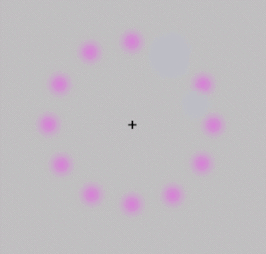
Troxler's fading, or the Troxler Effect, is an optical illusion affecting visual perception. When one fixates on a particular point for even a short period of time, an unchanging stimulus away from the fixation point will fade away and disappear. Recent research suggests that at least some portion of the perceptual phenomenon associated with Troxler's fading occurred in the brain.
Neural adaptation[]
Troxler's fading has been attributed to the adaptation of neurons vital for perceiving stimuli in the visual system. It is part of the general principle in sensory systems that unvarying stimuli soon disappear from our awareness. For example, if a small piece of paper is dropped on the inside of one's forearm, it is felt for a short period of time. Soon, however, the sensation fades away. This is because the tactile neurons have adapted and start to ignore the unimportant stimulus. But if one jiggles one's arm up and down, giving varying stimulation, one will continue to feel the paper.
Explanation of effect[]
Troxler's fading can occur without any extraordinary stabilization of the retinal image in peripheral vision because the neurons in the visual system beyond the rods and cones have large receptive fields. This means that the small, involuntary eye movements made when fixating on something fail to move the stimulus onto a new cell's receptive field, in effect giving unvarying stimulation. Further experimentation this century by Hsieh and Tse showed that at least some portion of the perceptual fading occurred in the brain, not in the eyes.
External Links[]
Coming Soon!
